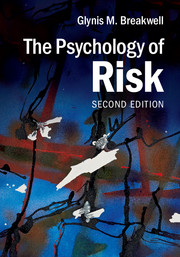Book contents
- Frontmatter
- Dedication
- Contents
- List of figures
- List of boxes
- Preface to the second edition
- Acknowledgements
- 1 A social psychological framework for analysing risk
- 2 Hazard perception
- 3 Individual and group differences in risk perception
- 4 Decision-making about risks
- 5 Risk and emotion
- 6 Risk communication
- 7 Errors and accidents; emergencies and disasters
- 8 Risk management; risk in complex systems
- 9 Social amplification, social representations and identity processes
- 10 Changing risk reactions: lessons from the psychology of risk
- References
- Index
6 - Risk communication
Published online by Cambridge University Press: 05 October 2014
- Frontmatter
- Dedication
- Contents
- List of figures
- List of boxes
- Preface to the second edition
- Acknowledgements
- 1 A social psychological framework for analysing risk
- 2 Hazard perception
- 3 Individual and group differences in risk perception
- 4 Decision-making about risks
- 5 Risk and emotion
- 6 Risk communication
- 7 Errors and accidents; emergencies and disasters
- 8 Risk management; risk in complex systems
- 9 Social amplification, social representations and identity processes
- 10 Changing risk reactions: lessons from the psychology of risk
- References
- Index
Summary
Chapter preview
This chapter considers the difficulties associated with risk communication and summarises the social psychological findings concerning the factors that may make communication persuasive. The use of the mental models approach to the design of risk communication strategies and messages is described. The impact of fear inducement on the efficacy of risk communication is assessed. The significance of trust in the process of developing the representation of the risk is examined. The effects of uncertainty upon the construction and efficacy of risk messages are outlined and the use of the precautionary principle as a determiner of risk management is critically assessed. The roles of the mass media as risk communicators are outlined. Pressure groups’ and minorities’ activities in negotiating the status of a hazard are briefly considered. The changing model of risk communication that is signalled by the use of consultation and participation methods is introduced. The difficulties associated with involving a broad spectrum of the public in such methods are noted and some suggestions for overcoming them are presented. The advent of digital communication systems and the rise of social media are considered in the context of risk communication and mitigation.
Communication about hazards and risks
Risk communication is very important. If done effectively, it can prevent or mitigate harm. It could be argued that communicating about hazards is just the same as any other sort of communication. Is there anything that sets risk communication apart – other than that it is about hazards and risks? One thing that makes it interesting, though not unique, is that it seems very difficult to do well. This may be because risk communication is seen basically to revolve around one party (A) trying to get another party (B) to accept a representation of a hazard that B finds any (or any combination) of the following:
incomprehensible – i.e. meaningless or confusing
unbelievable – i.e. inadequately substantiated
irrelevant – i.e. of no personal import
unacceptable – i.e. in conflict with other previously adopted systems of beliefs, values or self-interest.
- Type
- Chapter
- Information
- The Psychology of Risk , pp. 143 - 189Publisher: Cambridge University PressPrint publication year: 2014



